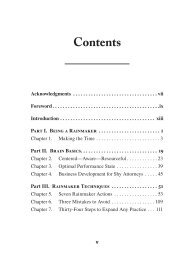(Bk Business) Carol Kinsey Goman Ph.D.-The Nonverbal Advantage_ Secrets and Science of Body Language at Work -Berrett-Koehler Publishers (2008)
Just
Just
Create successful ePaper yourself
Turn your PDF publications into a flip-book with our unique Google optimized e-Paper software.
Chapter 9: Transl<strong>at</strong>ing <strong>Body</strong> <strong>Language</strong> across Cultures<br />
155<br />
Head nods—yes <strong>and</strong> no A Canadian businesswoman, on<br />
a trip in India, stopped <strong>at</strong> the hotel’s concierge desk to ask<br />
about transport<strong>at</strong>ion to her meeting. “Does the hotel have<br />
a car service you could recommend?” <strong>The</strong> man behind the<br />
counter shook his head from side to side. “Is there taxi service<br />
to the <strong>of</strong>fice building?” Again, the man shook his head.<br />
Frustr<strong>at</strong>ed, the woman asked, “Well, how can I get there?”<br />
<strong>The</strong> man behind the counter calmly answered, “Whichever<br />
way you prefer,” while still moving his head from side to side.<br />
In most parts <strong>of</strong> the world, shaking the head up <strong>and</strong><br />
down indic<strong>at</strong>es “yes” <strong>and</strong> shaking the head left to right indic<strong>at</strong>es<br />
“no.” Indians however, tend to shake their heads about<br />
270 degrees to indic<strong>at</strong>e a “yes” as well as a “no.” This is a confusing<br />
gesture for people who do not underst<strong>and</strong> the prevalence<br />
<strong>of</strong> this practice on the subcontinent.<br />
<strong>The</strong> businesswoman might have been even more confused<br />
in Bulgaria, where a nod is “no” <strong>and</strong> a head shake<br />
means “yes.” In Japan there’s yet another twist: a nod <strong>of</strong> the<br />
head does not necessarily imply agreement; more <strong>of</strong>ten it<br />
only means th<strong>at</strong> the listener has understood the message.<br />
Eye contact <strong>The</strong> rules <strong>of</strong> eye contact vary from culture to<br />
culture. <strong>The</strong> Finns <strong>and</strong> the French expect direct eye contact,<br />
whereas the Japanese <strong>and</strong> the South Koreans tend to avoid<br />
it, considering it impolite <strong>and</strong> intimid<strong>at</strong>ing. In the United<br />
St<strong>at</strong>es, direct eye contact between strangers lasts for only a<br />
split second. In Italy, Spain, <strong>and</strong> other L<strong>at</strong>in countries, there<br />
is prolonged eye contact. But in L<strong>at</strong>in America as well as some<br />
African cultures, prolonged eye contact from someone <strong>of</strong><br />
lesser st<strong>at</strong>us is considered disrespectful. In the United St<strong>at</strong>es,<br />
people are taught to look <strong>at</strong> each other during convers<strong>at</strong>ions,<br />
but in some cultures avoiding eye contact by looking down<br />
is considered a sign <strong>of</strong> respect. Throughout Southeast Asia it’s<br />
best to avoid prolonged eye contact until the rel<strong>at</strong>ionship is<br />
firmly established.




